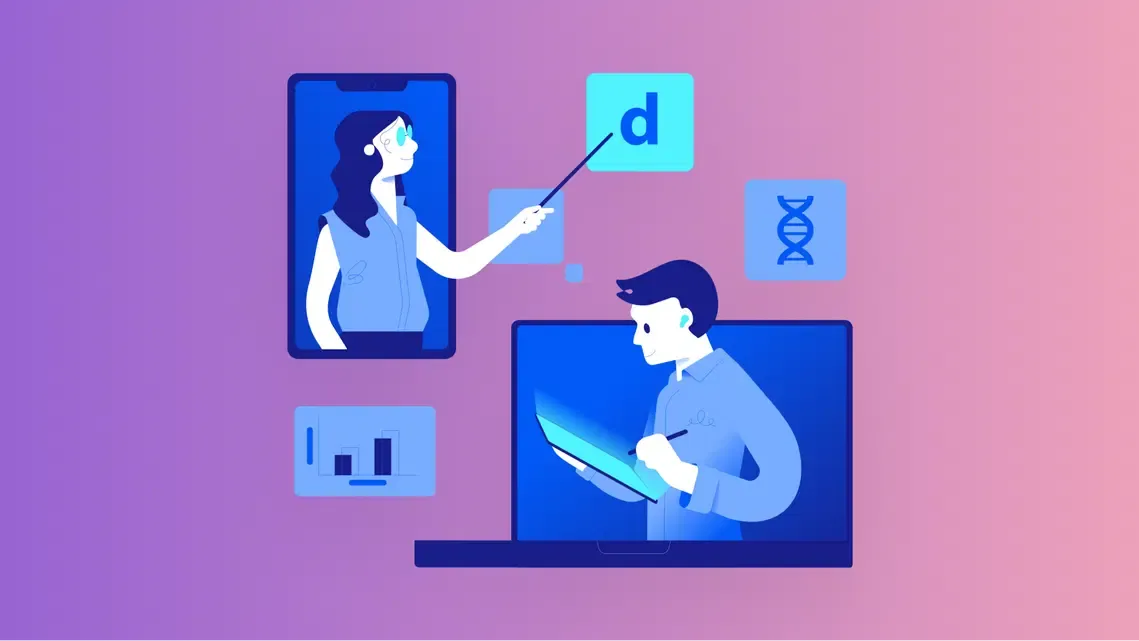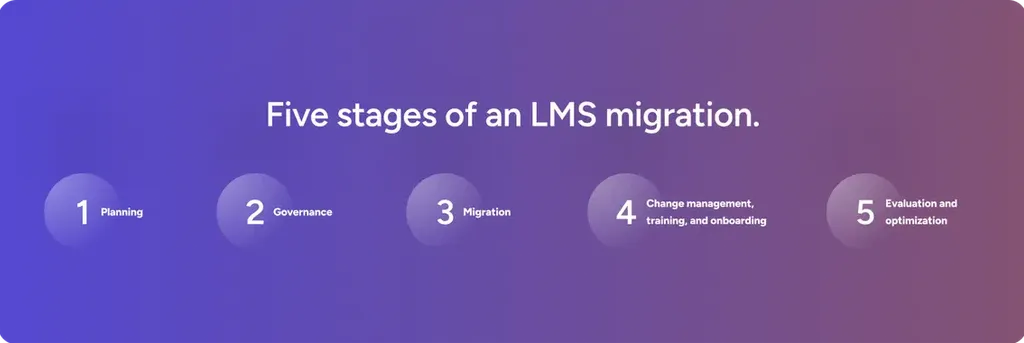The ultimate LMS migration guide: When and how to switch learning platforms

Only 25% of companies
use next-generation learning tools. But those that do are 2.6x more likely to hit their financial targets and 4.1x more likely to retain customers[1].
Skill gaps are the #1 barrier
to business transformation and attracting and retaining the right talent is the #1 concern among CEOs. Learning is critical to solve these challenges[2,3].
Switching platforms: Is it worth it?
When making any switch, it’s good to consider: ”What am I switching from and what am I switching to?” Getting a Porsche is always great. But it’s more great if you’re upgrading from a 1997 Kia and less great if you already own a Ferrari.
It’s the same with learning platforms. What do you have now and what are you getting? You can get to your learning goals a lot faster in a Ferrari than a Kia. Here are the most compelling reasons to switch:
- Skill-building. Six in 10 workers will need upskilling by 2027 but only half have access to the training they need [2].
- Customer education. How complex are your organization’s products and services? The answer is almost always ‘very complex.’ So, unless you’re selling staplers, it’s not enough to win customers; you need to help them get value quickly. Otherwise, they won’t renew. The average customer education program drives 7.4% better customer retention and a 6.2% increase in bottom-line revenue [4].
- Partner revenue. Partner ecosystems are a huge potential revenue driver. And yet more than six in 10 partners say they don’t get enough strategic guidance and seven in 10 say that onboarding programs should be streamlined and made more efficient [5].
- Opportunity cost. The cost of doing nothing is the largest cost of all. For example, look at content creation: It takes over 150 hours to create 18 minutes of engaging elearning content [6]. Switching to a learning platform that offers content or lets you build your own with AI will save your team thousands of hours—and considerable expense. What can your organization achieve with those extra resources? Unless you switch, you’ll never know.
- Measurement. Even though measuring the effectiveness of learning is the #1 challenge faced by L&D teams [7], 42% of organizations have NO strategy or standardized approach for it [8].
So ask yourself: Can your current learning platform meet the needs of every audience? Is it having the maximum possible impact on your learners and your organization? Or is your business still using the LMS equivalent of a ‘97 Kia?
Evolution and growth aren’t business risks. But stagnation is.

Diagnose your needs
Switching to a new LMS isn’t just about upgrading technology; it’s about addressing the challenges that are holding your organization back from reaching its full potential. Here are some common issues organizations face that can be traced back to their learning program (and their learning technology):
High employee turnover
Inadequate onboarding and a lack of learning opportunities are two of the largest contributors to employee turnover. More than nine in 10 employees would stay with their organization longer if they had more learning opportunities[9]. And nearly 70% of employees will stay with a company for 3+ years if they have a great onboarding experience [10].
High customer churn and poor product adoption
If your customers aren’t receiving the training they need to fully utilize your product, it can lead to high churn rates and poor product adoption. The power of customer retention has been known for decades now: Pioneering research from the Harvard Business School showed that a 5-point improvement in customer retention increases profit by 25-95%[11]. An effective customer education program does just that, improving customer retention by 7.4% on average and reducing support costs by 6.1%[4]. If customers are churning or not expanding their use of your product, it’s time to evaluate how your current LMS supports customer education…if it does at all.
Poor partner performance
Partners are an extension of your organization, and so is the partner experience. When a customer interacts with a partner, they see the experience as an extension of your brand. Unfortunately, 61% of partners say they lack strategic guidance and 70% say onboarding processes should be improved[5]. How healthy is your partner ecosystem? To find out, try comparing the CSAT of customers that leverage your partner network to those who don’t. If there’s a discrepancy, you should invest in partner training and enablement.
Learner disengagement
An intuitive and engaging user experience is essential for both learners and administrators. Gallup estimates that low engagement costs the global economy $8.8 trillion each year[12]. This tracks the data around learner engagement: More engaging learning practices like personalization and immersive learning make organizations up to 3x more likely to be high-performing [13]. Beyond the bottom line, poor learner engagement is also risky: It increases the risk of non-compliance as well as customer and employee churn.
Integration issues and challenges with your technology ecosystem
Today’s businesses use an average of 130 SaaS platforms[14]. Integration issues between your LMS and other systems create inefficiencies and data silos. A modern LMS should integrate smoothly with other tools, enhancing overall productivity and data consistency.
Low (or no) ROI
To build a program that drives ROI, you need robust reporting and analytics so you can measure and improve your learning initiatives. A modern learning platform can help you visualize performance at the business level, program level, course level, and even learner level. Any other strategy is just wishful thinking. Currently, only 27% of businesses have a framework for measuring learning success[15]—and many of those are only looking at vanity metrics as opposed to ROI and business impact.
A fear of scale (and an inability to scale effectively)
How would different stakeholders feel if the number of learners using your platform quadrupled tomorrow? Excited—or terrified? As your learning programs grow, your LMS should be able to scale with you. More learners should mean more champagne; not more work hours.
Of course, these pain points just scratch the surface. But they’re solid red flags that can help you make a compelling case for switching to a new LMS that better meets your organization’s needs and drives business success.
How would different stakeholders feel if the number of learners using your platform quadrupled tomorrow? Excited—or terrified?
Consider business context
Several organizational factors can influence the best moment to make this transition. Ask questions like this:
Are we expanding into new markets or geographies?
Entering new markets or geographies requires tailored learning programs to meet the unique needs of those audiences. This means the capability to manage version control, personalization, and translation for multiple languages.
Are regulatory and compliance requirements evolving?
A new learning platform with robust compliance management features can reduce risk and help you remain compliant with all regulations.
Is there rapid growth in our employee or customer base?
A significant growth in your employee or customer base can strain your current LMS. Our favorite example is Zoom: When the pandemic struck, they had a massive explosion in customers that needed training. They needed a customer training academy, fast. Fortunately, they used Docebo and within one month of launching their academy, they had trained over 100,000 learners. Today, that number is over 2,000,000.
Act at the right time
If you wait for the perfect time to update your learning platform, it will never come. But here are some factors that suggest it’s the right time and some tips to seize the moment:
Work around your current LMS’s update and contract schedule
If your current LMS is approaching the end of its lifecycle or requires big updates, it might be more cost-effective to switch to a new platform that offers the latest features and capabilities.
Consider budget cycles
Align the switch with your organization’s budget cycles to make sure the necessary funding is available. Consider the financial implications of the transition, including potential savings and the ROI of a more efficient LMS.
Align the platform with organizational strategy and goals
Time your migration to fit your organization’s strategic planning and long-term goals. A new LMS should support and enhance your overall business objectives. Position it as a strategic move, not just a tech upgrade.
Solicit feedback from learners, instructors, and administrators
User feedback can highlight critical areas for improvement and help identify the features that a new LMS must have to meet their needs. (Tip: Use verbatim quotes to help get buy-in for a new learning platform. Reading a valued customer’s angry rant has a motivating power that’s difficult to overstate.)
Model business impact
Evaluate how a new LMS will impact learning outcomes and business objectives. Consider the potential for improved engagement, better training results, and alignment with business goals. This assessment will help justify the investment and demonstrate the value of making the switch.
Show the ideal future state
Better learning technology positively impacts every part of the business. So make every part of the business an advocate.
For example, Sales teams see skills training and institutional knowledge sharing as tools that can help them hit quota faster. That’s the path to making them cheerleaders for learning. And because they thrive in competitive environments, gamification—with leaderboards and all—is a strong way to build engagement.
Meanwhile, Legal teams value partnership from leaders to ensure regulatory compliance, and both customers and IT teams appreciate the ability to self-serve instead of logging tickets and awaiting support.
The list goes on. Learning shouldn’t just live under HR—it should be supported by every part of the organization.
Getting buy-in from senior leaders
Getting your leaders aligned is a prerequisite for any investment, especially new technology.
Here are some tips:
- Have a clear vision that aligns with your existing strategy: Remember those four strategic priorities your C-Suite talked about at the last annual meeting? Tie your vision for L&D into those priorities.
- Emphasize business metrics: Use metrics and measures that leaders care about, like cost savings, revenue, and productivity. If you can bring in more advanced concepts, do that too.
- Tell stories: At the end of the day, leaders are people. Share case studies and success stories of companies that are similar to yours. And consider sharing a cautionary tale as well.
- Get ahead of common objections: Show that you have a plan to minimize organizational disruption during the switch and be ready to talk about how the biggest risk is continuing with the status quo. No leader wants their organization to fall behind.
- Communicate the personal benefits: We’re all people. So if learning can improve your senior leaders’ lives—from getting better results for the next board meeting to improving the odds of a promotion—touch on those benefits as well. Here’s a tip: If the leader is conservative and risk-averse, focus on the power of learning to mitigate risk and protect the organization from disruption. If the leader is ambitious, focus on the transformative power of learning and its ability to build the skills (and revenue) needed to be the disruptor.